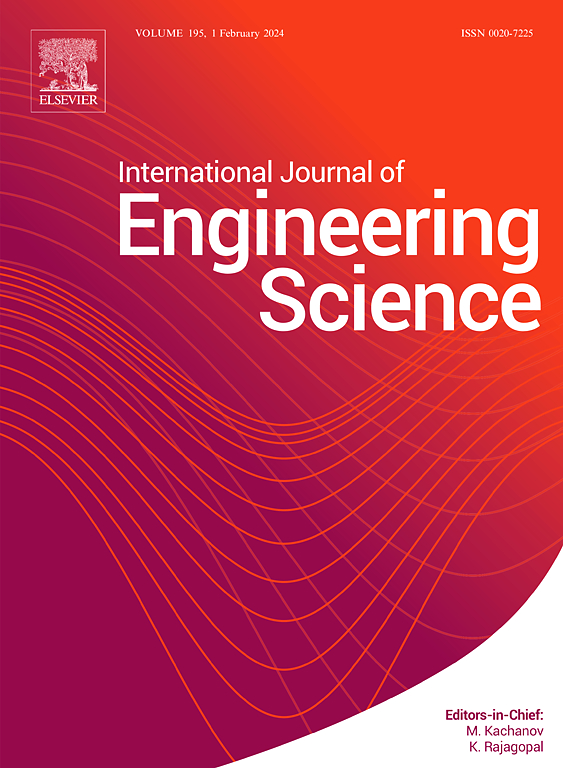Creep failure mechanism in single-lap joints
IF 5.7
1区 工程技术
Q1 ENGINEERING, MULTIDISCIPLINARY
International Journal of Engineering Science
Pub Date : 2025-06-04
DOI:10.1016/j.ijengsci.2025.104315
引用次数: 0
Abstract
The paper presents a study on adhesive creep mechanisms and failure in single lap adhesive-bonded joints, focusing on their time performance and durability. Adhesive connections, while advantageous for their uniform stress distribution, are susceptible to creep-progressive deformation under sustained loading. In the study, the adhesive creep behavior is modeled, employing advanced nonlinear FEA techniques and a probabilistic approach to capture the material complexities within the joint. Cohesive zone models and traction–separation laws are used to simulate crack initiation and propagation within the adhesive layer. The random field approach is used to govern the distribution of internal material imperfections. The results highlight the impact of creep on joint stiffness, ultimate strength, and damage progression over time, offering insights into the critical parameters affecting joint reliability and providing a basis for optimizing adhesive materials in structural applications. The material parameters used in the FE analysis were determined through experimental tests, and the numerical results were validated against experimental studies. The study demonstrates that the load capacity of the single-lap joint is significantly influenced by material imperfections, with their impact depending on both their percentage and location.
单搭接节点蠕变破坏机理
本文研究了单搭接胶粘接节点的粘接蠕变机理和破坏,重点研究了单搭接节点的时间性能和耐久性。胶粘连接虽然具有应力分布均匀的优点,但在持续加载下容易发生蠕变渐进变形。在研究中,采用先进的非线性有限元分析技术和概率方法对粘接蠕变行为进行建模,以捕获接头内材料的复杂性。采用粘接区模型和牵引分离规律模拟了粘接层内裂纹的萌生和扩展过程。采用随机场的方法来控制材料内部缺陷的分布。研究结果强调了蠕变对接头刚度、极限强度和随时间的损伤进展的影响,为影响接头可靠性的关键参数提供了见解,并为优化结构应用中的粘合剂材料提供了基础。通过试验确定了有限元分析中所用的材料参数,并将数值结果与试验研究进行了验证。研究表明,单搭接的承载能力受到材料缺陷的显著影响,其影响取决于材料缺陷的百分比和位置。
本文章由计算机程序翻译,如有差异,请以英文原文为准。
求助全文
约1分钟内获得全文
求助全文
来源期刊

International Journal of Engineering Science
工程技术-工程:综合
CiteScore
11.80
自引率
16.70%
发文量
86
审稿时长
45 days
期刊介绍:
The International Journal of Engineering Science is not limited to a specific aspect of science and engineering but is instead devoted to a wide range of subfields in the engineering sciences. While it encourages a broad spectrum of contribution in the engineering sciences, its core interest lies in issues concerning material modeling and response. Articles of interdisciplinary nature are particularly welcome.
The primary goal of the new editors is to maintain high quality of publications. There will be a commitment to expediting the time taken for the publication of the papers. The articles that are sent for reviews will have names of the authors deleted with a view towards enhancing the objectivity and fairness of the review process.
Articles that are devoted to the purely mathematical aspects without a discussion of the physical implications of the results or the consideration of specific examples are discouraged. Articles concerning material science should not be limited merely to a description and recording of observations but should contain theoretical or quantitative discussion of the results.
 求助内容:
求助内容: 应助结果提醒方式:
应助结果提醒方式:


